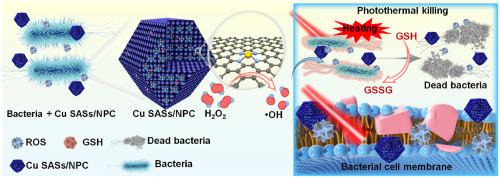Bioactive Materials ( IF 18.0 ) Pub Date : 2021-04-30 , DOI: 10.1016/j.bioactmat.2021.04.024 Xianwen Wang 1 , Qianqian Shi 2 , Zhengbao Zha 2 , Dongdong Zhu 2 , Lirong Zheng 3 , Luoxiang Shi 4 , Xianwen Wei 4 , Lian Lian 5 , Konglin Wu 4 , Liang Cheng 1

|
Nanozymes have become a new generation of antibiotics with exciting broad-spectrum antibacterial properties and negligible biological toxicity. However, their inherent low catalytic activity limits their antibacterial properties. Herein, Cu single-atom sites/N doped porous carbon (Cu SASs/NPC) is successfully constructed for photothermal-catalytic antibacterial treatment by a pyrolysis-etching-adsorption-pyrolysis (PEAP) strategy. Cu SASs/NPC have stronger peroxidase-like catalytic activity, glutathione (GSH)-depleting function, and photothermal property compared with non-Cu-doped NPC, indicating that Cu doping significantly improves the catalytic performance of nanozymes. Cu SASs/NPC can effectively induce peroxidase-like activity in the presence of H2O2, thereby generating a large amount of hydroxyl radicals (•OH), which have a certain killing effect on bacteria and make bacteria more susceptible to temperature. The introduction of near-infrared (NIR) light can generate hyperthermia to fight bacteria, and enhance the peroxidase-like catalytic activity, thereby generating additional •OH to destroy bacteria. Interestingly, Cu SASs/NPC can act as GSH peroxidase (GSH-Px)-like nanozymes, which can deplete GSH in bacteria, thereby significantly improving the sterilization effect. PTT-catalytic synergistic antibacterial strategy produces almost 100% antibacterial efficiency against Escherichia coli (E. coli) and methicillin-resistant Staphylococcus aureus (MRSA). In vivo experiments show a better PTT-catalytic synergistic therapeutic performance on MRSA-infected mouse wounds. Overall, our work highlights the wide antibacterial and anti-infective bio-applications of Cu single-atom-containing catalysts.
中文翻译:

具有光热性能和增强纳米酶活性的铜单原子催化剂用于细菌感染伤口治疗
纳米酶已成为新一代抗生素,具有令人兴奋的广谱抗菌特性和可忽略不计的生物毒性。然而,它们固有的低催化活性限制了它们的抗菌性能。在此,通过热解-蚀刻-吸附-热解(PEAP)策略成功构建了铜单原子位点/氮掺杂多孔碳(Cu SASs/NPC),用于光热催化抗菌处理。与未掺杂Cu的NPC相比,Cu SASs/NPC具有更强的类过氧化物酶催化活性、谷胱甘肽(GSH)消耗功能和光热性能,表明Cu掺杂显着提高了纳米酶的催化性能。 Cu SASs/NPC在H 2 O 2存在下能有效诱导类过氧化物酶活性,从而产生大量的羟基自由基(•OH),对细菌有一定的杀伤作用,并使细菌对温度更加敏感。引入近红外(NIR)光可以产生高温来对抗细菌,并增强类过氧化物酶的催化活性,从而产生额外的·OH来消灭细菌。有趣的是,Cu SASs/NPC可以作为GSH过氧化物酶(GSH-Px)类纳米酶,可以消耗细菌中的GSH,从而显着提高灭菌效果。 PTT催化协同抗菌策略对大肠杆菌( E. coli )和耐甲氧西林金黄色葡萄球菌( MRSA )产生几乎100%的抗菌效率。体内实验显示对MRSA感染的小鼠伤口有更好的PTT催化协同治疗性能。 总的来说,我们的工作强调了含铜单原子催化剂的广泛抗菌和抗感染生物应用。
















































 京公网安备 11010802027423号
京公网安备 11010802027423号